"Understanding the wide range of mesh preparation products, and when to use them, can be a challenge. This guide will clearly explain the product similarities and differences, as well as how to properly use mesh preparation as a part of your process improvement program."
Many process breakdowns in screen printing can be traced back to screens and screen making. Print jobs that consistently suffer from pinholes and premature breakdown on the press can often be improved by adopting the industry’s best practices. A great place to begin is proper mesh preparation procedures. Understanding the wide range of mesh preparation products, and when to use them, can be a challenge. This guide will clearly explain the product similarities and differences, as well as how to properly use mesh preparation as a part of your process improvement program.
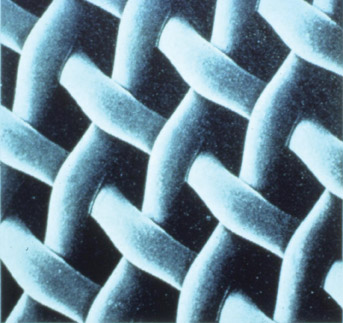 |
| Mesh showing smooth surfaces |
Even though mesh manufacturers give their finished mesh a good cleaning after it is woven and heat-set, rolled mesh gets handled in packing and shipping at the distributor location, and again at your factory when the mesh is received and stretched. All of this handling leaves greasy residues, dust, and dirt on the mesh, any of which can interfere with stencil adhesion, and contribute to premature stencil breakdown. Proper preparation of the mesh is an inexpensive way to prevent fisheyes, pinholes, and premature stencil breakdown.
Mesh preparation is broken down into two key steps: Abrading and degreasing. Abrading is used only with stencil films, and not liquid-direct emulsions. But note, every screen should be degreased.
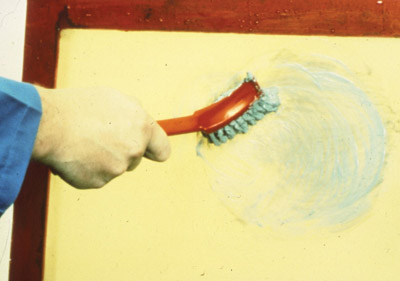 |
| Apply abrader with soft bristle brush. |
Abrading
Abraders come in powder, paste and gel forms. Modern polyester mesh threads are extruded (similar to fishing line), and are slick and smooth so stencil films do not adhere readily. Abrading the mesh increases the surface area on the knuckles for better gripping by the stencil film. Abraders are fine silicon carbide micro-grit preparations. Surprisingly, despite their effectiveness, they don’t feel rough when rubbed between your fingers! This is because the particles are so fine.
Abrading the mesh is accomplished by applying a small amount of mesh abrader onto the substrate or print side of the mesh with a soft brush, and lightly scrubbing it. Abraders do not need to stand on the screen and can be rinsed off immediately with a firm pressure spray.
Effective mesh abraders include Autotype Autoprep paste and Ulano #2 Microgrit powder.
Do not use household scouring powder to abrade your mesh! Even though Comet® or SoftScrub® costs $2 instead of $20, these household cleaning products are too abrasive, and guaranteed to shred the surface of your expensive mesh. This will reduce the screens’ life and leave lots of deep gashes and pits where ink and emulsion can accumulate and become lodged, thereby increasing staining, ghosting and hazing problems in the screen. Even with the proper product, testing at the Screen Printing Technical Foundation (SPTF) has shown excessive abrading will reduce screen life. The best advice is to do it once when the mesh is brand new, then again if necessary after five or six stencils.
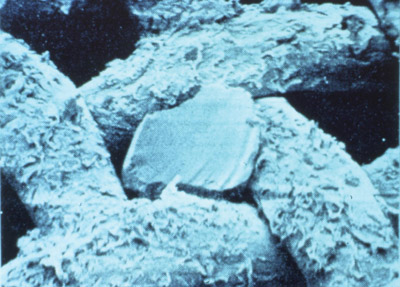 |
| Mesh abraded with scouring powder |
Degreasing
Mesh Prep Rule #1: Degrease every screen you ever make for as long as you live! Degreasers are broken down into two main categories: those with wetting agents and those without. The easiest way to see if your degreaser has a wetting agent is to degrease one half of a screen and compare how the two sides hold water. Apply the degreaser in question to the right half of a screen and leave the other half untouched. Scrub the degreaser well into the mesh, and leave it to stand for a minute or two. Then flood rinse the screen, and hold the mesh at an angle until you can see if the mesh holds water. A degreaser with a wetting agent will leave a smooth, even, glossy sheet of water across the mesh, compared to the control side where droplets and rivulets form and run off without sheeting.
Degreasers without wetting agents are designed for use with liquid-direct stencil emulsions. They are designed to remove dirt and greasy residues left by inks and ink cleaners. Some examples of popular degreasers without wetting agents include Ulano #3 Degreaser, Ulano #33 Degreaser Concentrate, Chemical Consultants (ICC) Nutralyze, CPS Degreaser Concentrate, Chromaline Chroma/Clean Mesh Degreaser, Fujifilm Sericol Xtend XMP-HD (Heavy Duty), KIWO Degreaser 1:20 (strong foaming action) and 1:40 (reduced foaming).
Wetting agents are essential for a stencil film’s good adhesion, although many stencil technicians report that they also improve its coating ability for liquid emulsions. With stencil film, you can use either a degreaser with a wetting agent or separate degreaser and wetting agent. Generally, if water sheets smoothly across the mesh, even liquid emulsions with about 60 percent water will flow and sheet better. If water is repelled from the screen mesh, it will flow in little rivulets and form droplets on the mesh. Degreasers with wetting agents include Autotype Universal Mesh Prep, Fujifilm Sericol Xtend XMP-AC (Aqua Coat), Ulano Magic Mesh Prep, KIWO Dual Prep, Easiway Mesh Preparation, Chemical Consultants Liqua-Prep and Prep-Rite and the new KIWO Ultra Prep.
Some manufacturers make a wetting agent separate from the degreaser, such as Ulano #25 All Mesh Prep and Chromaline Chroma/Wet Wetting Agent.
Some degreasers — such as CPS Degreaser Concentrate, Ulano Magic Mesh Prep, and KIWO Ultra Prep — contain anti-static additives to help prevent the screens from attracting dust. This can significantly reduce pinhole problems caused by dust and dirt.
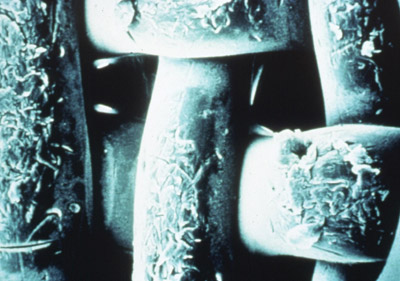 |
| Damaged mesh from abrasion. |
Household dish detergents are not effective screen degreasers because most brands contain lanolin or wool grease, which keep human skin from drying out while doing the dishes. These additives leave greasy films and contaminants on the screen mesh. However, for automatic degreasing equipment systems, non-foaming detergents can be used as effective degreasers. While you should consult a detergent specialist for recommendations, I have seen both laundry powders and automatic dish detergents used with varying degrees of success.
If you abrade or degrease several screens in a row, the initial screen will have been left to stand long enough and should be ready for rinsing by the time you have degreased the final screen. Rinse generously, as any remaining detergent or abrader on the mesh will act as a contaminant!
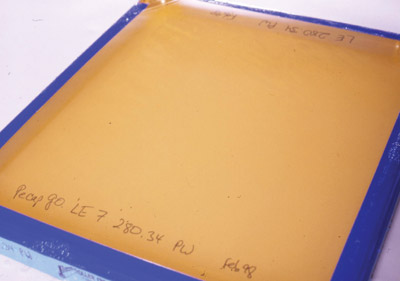 |
| Undegreased mesh. |
Combination degreasing and abrading
Mesh abraders and degreasers sometimes are combined into one product. Examples include Ulano #23 Roughening/Degreaser Gel, Chromaline Chroma/Brade Mesh Abrader/Degreaser gel and Chemical Consultants ADS-301 Abrader/Degreaser/Stain Remover.
Sometimes caustic or etching degreasers and abraders also can be used, such as Autotype Autopaste and KIWO Pregan NT Paste. These alkaline products are particularly effective with mesh that is heavily stained with ink and emulsion residues. Some companies, such as Intercontinental Chemical Co. (ICC), incorporate an alkaline degreaser into the haze remover.
Since these products finely etch the mesh, it is important to follow the manufacturer’s guidelines for dwell time when using alkali degreasers. (Sodium hydroxide and/or potassium hydroxide also are found in many ghost, haze and stain removers.) In my early days as a screen maker, I vividly recall being shown how to degrease with the caustic degreaser, and then neutralize the mesh with a solution of glacial acetic acid! I’m not sure that I would accept the same meshes as properly prepared today, but now it is certainly easier and less dangerous to use modern mesh preparation agents.
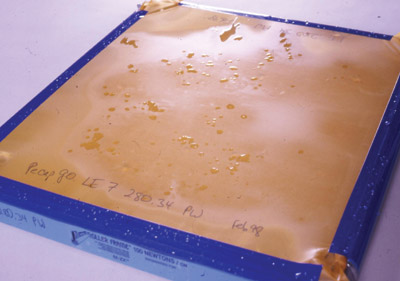 |
| Screen degreased without wetting agent. |
Other Products and Chemicals in Screen Preparation
Bleach is still occasionally used as an emulsion remover, or more effectively as a diazo stain remover. To remove diazo stains from underexposed stencils, bleach can be brushed onto dry mesh and allowed to dry — before being flood rinsed — and then pressure washed to remove any traces of stain and chemical. Excessive use of bleach can affect some of the anti-halation dyes used on colored meshes. The same way that bleach can eventually damage your jeans, it can also damage or embrittle your mesh. Also, ventilation systems are imperative if bleach is used in your screen preparation area.
Tri sodium phosphate has previously been used as a combination degreaser and abrader. However, it is really too abrasive for screen mesh, and it does not degrease as well as proper screen degreasers, so screen technicians are advised to select fit-for-purpose mesh preparation products.
Abrasive furniture polishes — such as Rottenstone (a soft decomposed limestone) and pumice (a lightweight rock of volcanic origin that is used to scrub calluses and soften the feet) — are too abrasive for your expensive screen mesh, so remove these products when implementing industry best practices.
Commercial grill and floor degreasers can be used on screen mesh with varying degrees of success. Test carefully to ensure there are no residues or contaminants remaining. Liquid Plumber®, Drano®, Red Devil® Lye crystals and other drain openers are corrosive products designed for the removal of clogs from household drains. They are not safe for use on screens. Don’t use them.
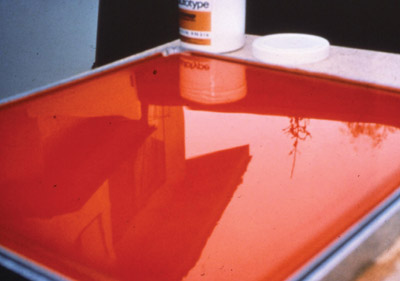 |
| Screen degreased with wetting agent. |
Popular multipurpose household cleaners such as Simple Green, Window Cleaner and Orange Spray & Wipe Cleaners (usually containing 5 percent to 15 percent d-Limonene) also leave too much residue on screens and should not be used for cleaning or degreasing screen mesh.
Straight d-Limonene by itself is not water miscible so it is not an effective mesh degreaser. However, it can be mixed with surfactant packages to make it water dilutable and rinseable. Then, it can be effective as a frame degreaser, though it is not recommended for degreasing screen mesh. D-Limonene is pressed and steam distilled from orange peels. Since it smells like oranges, people can sometimes assume that it is a totally safe product, when in fact it can de-fat the skin. Safety gloves and shop glasses should be used, just as with any other industrial product.
In Conclusion
Chemical manufacturers design a variety of products for use in mesh preparation. Use mesh abraders only when using stencil films, such as capillary and indirect gelatin ones. All screens should be degreased. Degreasers with wetting agents are essential for stencil films, but almost any mesh degreaser can be used with liquid-direct emulsions. Mesh preparation is inexpensive and easy to overlook, but implementing a best-practices approach will improve stencils, and minimize potential problems from contamination, fisheyes, pinholes and premature stencil breakdown.
This article appeared in the SGIA Journal, 2nd Quarter 2007 Issue and is reprinted with permission. Copyright 2007 Specialty Graphic Imaging Association (www.sgia.org). All Rights Reserved.



